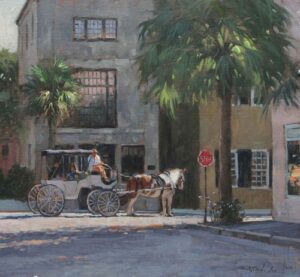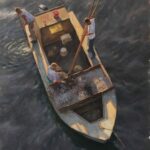
In the past parents discouraged their kids from becoming an artist because many starve. Thus starving artist. But if this is truly what you want to do, you must be “all in” and go at it with not only your passionate artist heart, but the mind of a business person. My background as an illustrator gave me a thick skin when it came to rejection and from that I knew the “art ride” would be a roller coaster. One success would erase 10 failures.
When I entered the illustration field the big names where already established so I had to hustle even more. Dragging my portfolio all over New York sometimes felt like I was invisible.
My portfolio had to be relevant for the times. I would look at magazines and books on the stand and see what was selling. Was it something I wanted to do or was even capable of? So I had to redo my book every few years as I gained more tear sheets from jobs, showing only my best.
Fine Art is no different in the marketing aspect. What are galleries showing and will my work fit? Some galleries only show abstract while others feature mostly representational or a mix.

Another big consideration is your price structure. When just starting your prices should be low with gradual increases annually based on sales, exposure, awards, etc.
Your price structure will be a factor when entering a gallery. If you are low it might hurt the other artists and if you are high collectors might pass you by favoring a lower priced artist. It is the job of the gallery to educate collectors as to why this artist demands their prices.
As you build your sales, it’s important to increase your price structure gradually, because if you go too high too soon you can never go back down. If a collector buys your painting and finds out you had a fire sale on the same size painting they will not be happy and you may lose a loyal collector.
Most galleries will show art that reflects the area, so depending on the region your scene of palm trees may only sell in galleries along the Gulf Stream. Ideally, if your subject matter sells in any gallery you will be able to rotate your work through all your galleries for each season.
Framing your painting is the packaging for your product. The right frame will either make your painting sing or groan. I see many good paintings with cheap frames that suggest the artist doesn’t care about the final presentation.
 When you have finally broken into a gallery, you are in a trial mode. The gallery owner needs to get a reaction from your art. Collectors have to gravitate to your art and with the help of the gallery may decide to purchase your painting. Red sticker “Sold”!
When you have finally broken into a gallery, you are in a trial mode. The gallery owner needs to get a reaction from your art. Collectors have to gravitate to your art and with the help of the gallery may decide to purchase your painting. Red sticker “Sold”!
This is such a big thrill for an artist, because the Collector wants to live with your art. It is the very best compliment.
Now your stock in the gallery has gone up and after a few sales you might be offered a show.
The best galleries will suggest but never tell you what to paint. If seascapes are selling then paint them. My subject matter is fairly broad so I might have several different things I like to paint that collectors like as well.
When your art isn’t selling don’t panic! “There is a collector for every painting”

Paintings could sit in a Gallery for a couple years and then a Collector walks in. Or you may move the same work into another gallery and it sells quickly.
The main thing is you must never lose your pure excitement and passion for painting.
If you are excited about what you are painting others will feel that too. Painting something that you think might sell cannot stand by itself without the passion. This will reflect a struggle and collectors will ignore it.
As artist’s, we constantly learn from each other and it’s great to spend time and share your thoughts. Teaching workshops not only is an added source of income but helps you verbally articulate what you do. This well improve your painting skill when teaching others. Your students may also be future collectors.
Advertising, Website, and Social Media
Taking out ads in art magazines, maintaining a strong website, and using all forms of social media puts you out there. You may be a Master in your own studio but if no one knows about you, It might as well be a hobby.
I find my website is being looked at every day whether it is 15 or 100 people. I use FASO, and this site helps me upload and change my site whenever I want. It also gives me website traffic info. What are folks looking at, for how long and what part of the country are they from.
More and more collectors are looking at websites, so it is probably your single most important vehicle to put you out there. More articles on websites for artists.
Social media, like Facebook is a lot of fun and sometimes a huge time killer.
When I am done with a painting I’ll post a few of them on Facebook to get a reaction. Sort of a pre-marketing thing. General public reaction can give you a good idea of how well collectors might view it.
If anything, it gives us an ego stroke if other artists “comment”, or ” like it”. The camaraderie of social media helps artists gain encouragement and we all need that, as long it doesn’t over inflate our ego.
Finding the balance between the business side of art and staying true to ourselves as artist’s maybe different for each of us. Making a living as an artist is a great calling that hopefully improves other people’s lives as well as letting you have a wonderful and full life.







